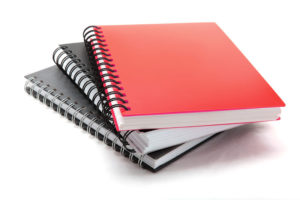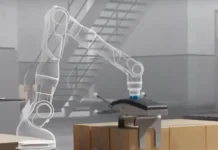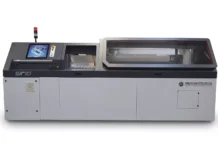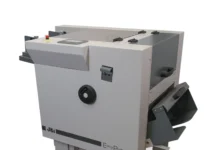By Katy Ibsen, managing editor
PostPress
There is no shortage of thick books in this world that required a special binding; text books, novels, educational tools, training manuals, dictionaries and so forth. We’ve all had the opportunity to connect with a thick book.
When a client brings a thick book to your bindery, it’s important to understand what they are trying to achieve in order to determine the best or most efficient type of binding. Questions to ask include: How many pages? Is there a desire for a spine, and will the number of pages accommodate having a spine? What type of front and back covers will be used? Will there be inserts or tabs in the book? What type of substrate will be used for the body of book (type of material, weight and print coverage % of the pages)?
To help understand this, we pay particular attention to these questions in the category of cookbooks.
Cookbooks are taking on lives of their own, now going beyond just an anthology of recipes. Furthermore, cookbooks are used for fundraisers and other special projects for social organizations like Junior League, or special interest publications produced by city/regional magazine brands. The design, photography, editorial content, paper and binding all play an important role in the book’s brand.
“Binding is such an important part of the printed piece and should be considered early on,” said Sabine Lenz, founder of PaperSpecs. “Not every binding technique is suitable for every purpose.” This growing trend creates new job opportunities for a bindery. Here, PostPress explores the options of binding thick books.
Coil binding
 Coil or punch binding can be a popular option among smaller publishers or clients that have a project needing efficient binding that is not subject to style or branding. Examples include training materials, finance and legal documents, directories or regional cookbooks.
Coil or punch binding can be a popular option among smaller publishers or clients that have a project needing efficient binding that is not subject to style or branding. Examples include training materials, finance and legal documents, directories or regional cookbooks.
John Lugviel, vice president sales and marketing at Rhin-O-Tuff, shares more about punch and coil binding.
“Our solutions focus on lay flat binding because of its durability, lay-flat qualities and ability to be taken apart for document revisions,” he said.
Lugviel points to a study on binding by Interquest research, which revealed that coil binding is used for lay-flat documents more than half of the time.
Of the binderies/facilities surveyed in the Interquest study, lay flat proved to be the popular binding option.
The data states:
- Training and education documents, marketing and sales materials, and finance/legal documents were the most common types of documents ordered with lay flat bindings, accounting for nearly 75% of those surveyed.
- Top vertical markets ordering lay flat bindings included: Education (Higher Education and B2B), Finance & Legal, and Government & Nonprofit. At Rhino-Tuff, Human Resources, Sales & Marketing and Finance are the most common clientele.
- 86% of those surveyed reported that lay flat binding was applied to letter size, 8.5×11″ documents.
- The survey revealed that, on average, 58% of the cover material is uncoated card stock, 18% is coated card stock, 17% of the material is clear acetate, 6% is vinyl and only about 1% is laminated.
Depending on a book’s content, design and layout, the punching will require some consideration. Lugviel says, “When choosing the best punch technology solution for your large book jobs, it comes down to volume and book structure, i.e. tabs, cover types and inserts. If you are binding many books with over 200 sheets (400 pages) per book, an automated punch may be the best solution. There are several high-speed punches in the market but only one that we are aware of that will insert tabs and difficult cover types, such as acetates, poly’s, UV-coated and laminated materials.”
For large jobs, Lugviel recommends an automated coil inserter with a plastic coil, with a 4:1 oval die. “There are several of these automated electric coil inserters available in the market. The costs for this type of equipment ranges from $15,000 to $30,000 until you get into the high-speed production category, which can go as high as $150,000,” he said. For wire-o (double loop wire) closing, Lugviel points out that there are a wide range of solutions from an automated standpoint, and they range from $30,000 to $150,000.
For small jobs, Lugviel suggests tabletop punch and binding solutions. “We would recommend a punch with interchangeable die capability,” he said. “This would allow users to use the same punch for plastic coil, wire-o and comb punch patterns.”
For plastic spiral binding elements for larger books, Lugviel recommends a 4:1 oval die pattern and a tabletop electric coil inserter. This pattern gives users a larger hole to insert the coil. If wire-o is required, a 3:1 (three holes per inch) round or square punch pattern is recommended for larger books.
Larger than 120 sheets, a 2:1 (two holes per inch) round or square die pattern would need to be used due to margins needed to bind the book without tearing the sheets. 2:1 wire standard sizes go up to 1 ½” and 300 sheets (600 pages) of 20lb paper. There are larger sizes, but they generally are custom made.
Thread sewn
Another popular option for lay flat and aesthetics is thread sewn binding. Also referred to as section sewn binding, pages are sewn together before covers are added, creating a visual effect that is also durable – ideal for cookbooks.
PaperSpecs, the online resource center for creatives working with paper, pointed to DISH cookbook, a special edition featuring recipes from famous chefs across Australia, as a beautiful example of Smyth sewn binding with bright blue thread that matches the book’s cover.
The Bindery, based in Australia, provided the thread sewn binding for DISH, which PaperSpecs credits for enhancing DISH’s “homemade feel, suggesting that this is indeed a piece to be treasured.”
Books that will experience some wear and tear are good candidates for thread sewn binding because there is an assurance that there is never a glue failure. The Bindery provides additional tips on best practice for thread sewn binding.
- 16- or 32-page sections are required for sewing. (If printing as four- or eight-page sections, then the job should be planned so as to insert one into another to make 16-page sections.)
- Any odd 4pp or 8pp sections must be imposed to insert or wrap around a 16- or 32-page section.
- All sections must have a minimum of a 7mm and a maximum of 12mm lap edge.
- The lap edge can be either on the back half or front half of the section but must be on a common edge throughout all sections of the book.
- All inserts and wraps must be the same size as sections and have the same lap edge as the sections.
- All folded sections must be the same size from head to tail, and a spine measurement is required.
According to Lenz, books that show off the smyth sewing are on trend. She states that swiss binding is also popular, where the text block is glued to the inside back cover as opposed to the spine itself.
“Binding is a very important part of the overall design, the look and feel of a book, and thus should reflect the branding,” she said.
It’s also important to note that not all threads are created equal; thicker books have always been smyth sewn, to provide a lay flat quality and overall longevity to the book.
Perfect binding
Perfect bound cookbooks often are not as lengthy as their hardcover counterparts and will not lay flat; making it a less desirable option among publishers. The option is economical, however, and depending on the content of the book or trim size, may still have a purpose. It certainly is less costly, especially for large quantities.
Perfect binding a thick book with a soft cover will call for adhesive, and binderies have options: polyurethane reactive (PUR) or ethylene-vinyl acetate (EVA).
As previously covered in PostPress (see PUR or EVA – What is the Best Adhesive Option, Nov/Dec 2018), each has different qualities that might make it the correct option for different types of books.
PUR adhesive has many advantages. It can bind varnished, UV-coated, carton, mylar and other difficult stocks, where EVA adhesive may struggle with certain coatings or substrates. PUR also is compatible with digital printing because the kind of adhesive isn’t affected by ink migration.
Perfect binding can accommodate up to 400 pages and can be bound faster than thread sewn. PUR also provides a substantial adhesive, especially on coated papers and difficult paper stock, which makes it a better choice for larger books. The challenge of getting perfect bound books to lay flat is a challenge and must be looked at carefully.
Whatever the recipe, there are plenty of options for the perfect thick book binding.





